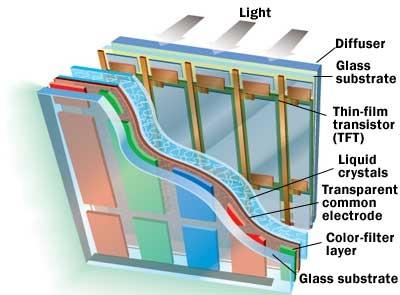Inner Workings: Inside a Liquid-Crystal Display (LCD)

The granddaddy of fixed-pixel technologies, LCDs first appeared in pocket calculators in the early 1970s. LCD technology is amazingly versatile, able to power front projectors, rear-projection TVs, and flat-panel displays.
In an LCD, a matrix of thin-film transistors (TFTs) supplies voltage to liquid crystal-filled cells sandwiched between two sheets of glass. As with plasma panels, a trio of red, green, and blue cells makes up one pixel. When hit with an electrical charge, the crystals "untwist" to filter light generated by a lamp behind the screen (for flat-panel TVs) or a lamp shining through a small LCD chip (for projection TVs).
LCDs have a lot of advantages. Direct-view models are only a few inches deep and are available in screen sizes as small as 15 inches. Compared to plasmas, LCDs usually have higher resolution at comparable screen sizes, and relatively affordable 1080p LCDs are becoming available. LCD panels weigh less and consume less power than plasmas. And, unlike single-chip DLP models, LCD projectors aren't subject to the rainbow effect some viewers experience - flashes of multicolored light occasionally and fleetingly visible around bright objects in motion against dark backgrounds.
But of the fixed-pixel technologies (which also include plasma, DLP, and LCoS), LCD has historically had the most trouble producing deep blacks. Some light always passes through, so the best black is usually a very dark gray. The newest LCDs, however, are better with this, and some approach the best plasmas in reproduction of deep blacks. Also, because of the way light goes through LCD cells, flat-panel LCDs still have narrower viewing angles than plasma TVs.
LCD has always dominated the flat-panel market under 42 inches, but until the last year or so high prices have slowed widespread adoption of bigger models. In 2006, however, 40- and 42-inch LCDs have dropped to plasma price levels, and they're experiencing a surge in popularity. Rear-projection LCDs compete with DLP sets and sell for about the same prices, while front-projection LCDs are typically less expensive for the same resolution than their DLP competition.




























































